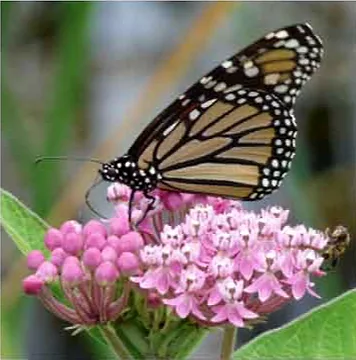Why native plants? Native, or indigenous, plants are plants that have evolved in the North American landscape prior to European colonization. Native plants are adapted to a particular region’s climate and soils. Native plants have formed complex interrelationships with our local wildlife over thousands or millions of years of evolution. They provide food and shelter for our wildlife and insects that sustain the food web of our ecosystem.
 Because native plants are well‑adapted to our local landscape, they require little watering once established, and far less fertilizing, reducing our carbon footprint and preserving water, our most vulnerable natural resource.
Because native plants are well‑adapted to our local landscape, they require little watering once established, and far less fertilizing, reducing our carbon footprint and preserving water, our most vulnerable natural resource.Manicured lawns provide space for recreation and their well kept appearance appeals to many people. Today, lawns in the US cover more than 63,000 square miles—roughly the size of Texas. Dominated by non-native species of turfgrass, these lawns require a staggering amount of water, fertilizers, pesticides, gasoline, and labor to keep them groomed and tidy. The environmental and economic costs are significant.
If you want to do something good for the environment, consider naturescaping, a landscaping method using natural features rather than trying to adapt non-natives to your yard. Converting a portion of your lawn to native plants, and replacing non-natives with natives, is a cost-effective and ecologically sound approach that offers a host of environmental, financial, and aesthetic benefits.
 Bringing native plants back into the garden is critical to preserving biodiversity and protecting against climate change. It’s time to say goodbye to manicured landscapes and embrace naturescaping!
Bringing native plants back into the garden is critical to preserving biodiversity and protecting against climate change. It’s time to say goodbye to manicured landscapes and embrace naturescaping!
Tips for Starting a Native Landscape:
• Start small. Work an area that is manageable for a season – there is always time to expand!
• Start with healthy soil. Test your soil so you know what nutrients you need (www.ag.umass.edu/services/soil-plant-nutrient-testing-laboratory)
• Add compost and leaf mulch to build up healthy soil organisms, which will break down materials into vital nutrients for plants.
• At the end of the growing season, amend the soil with leaf mulch from leaves in your yard. This will protect the plants over the winter while continuing to provide nutrients for plants and soil organisms. You can provide habitat for overwintering beneficial insects by leaving 18 inches of stems in place.

• Plant the right plants in the right place. Grouping plants with similar needs will allow them to thrive without lots of maintenance.
• Plant with successive bloom periods for beauty and benefits all season long.
• Water wisely. All plants need water to get established, but native plants will require far less once they are established.
For More Information:
www.xerces.org/pollinators-northeast-region
www.audubon.org/native-plants
www.grownativemass.org/resources/nurseries
Reprinted with permission from the Town of Concord, Division of Natural Resources.
All photos courtesy of Cherrie Corey.



